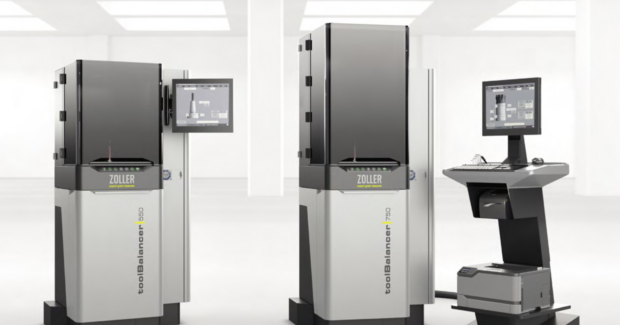Why Tool Balancing can Benefit Every Machining Operation
Balancing tool assemblies set the stage for smooth machining that produces parts with consistent surface finish. Balancing also accelerates production because speeds and feeds can increase without compromising the part.
Posted: November 16, 2024
Let’s start with a controversial premise: deciding whether to incorporate a tool balancing machine into production should take into account more than just spindle speed. In fact, spindle load — essentially a gauge of how hard a CNC machine’s spindle is working — is a much more insightful metric to consider.
Tool balancing machines measure and correct unbalance in tool holders, tool assemblies and grinding wheels, whether with balancing screws, balancing rings or removal of material. For decades, the conventional wisdom was that these machines were necessary only for high-speed machining operations where spindle speeds exceed 15,000 rpm. Today, however, there is a growing realization that balancing offers substantial benefits across all machining operations, even at lower speeds.
Spindle load is an important indicator of how efficiently a shop utilizes its CNC machines. While every production is unique, most shops with fairly modern CNC machines should achieve spindle loads of 80% or higher — a target that is safe and attainable with balanced tools. As an example, for shops running at only 10% to 15% spindle loads, the first question is always what is behind that significant underutilization? Answers vary, but unbalanced tools are often a factor.
Of course, a tool balancing machine is just one part of the equation. The most efficient shops use tool presetters to accurately measure tools outside the CNC machine. Quality tool holders and a robust tool management system to track data, including tool life, are also vital. As you weigh if a tool balancer could improve your operation, consider several of these other benefits.
Smooth, Consistent Surface Finish
Machining with balanced tools reduces vibrations in the spindle and workpiece that affect surface finish.
Especially in industries with high tolerance requirements, such as aerospace, medical, grinding and mold and die, even minor variations can result in customer rejections, scrapped parts and longer lead times.
Balancing tool assemblies set the stage for smooth machining that produces parts with consistent surface finish. Many operations also discover that balancing accelerates production because speeds and feeds can increase without compromising the part.
Extended CNC Spindle Life and Tool Life
Using balanced tools reduces wear on a CNC machine’s spindle and extends its service life, often by several years. Along the way, it also minimizes the risk of machine crashes, tool breakage and other costly catastrophes.
Unfortunately, many companies find out too late that the cost of replacing a single CNC machine spindle far exceeds the investment in a balancing machine that could have serviced the entire shop. This doesn’t even factor in the cost of having a machine down for weeks.
While improved spindle life from balancing may take longer to fully realize, a noticeable increase in tool life is usually immediate. One manufacturer in the aerospace sector recently shared that their tool life more than doubled after integrating regular tool balancing into production. That is common feedback from tool balancer customers.
Efficient and Safe Processes
Tool balancing is an investment in a shop’s future, one that enhances the safety and productivity of the workforce.
Balanced tools ensure safer work conditions, particularly in grinding wheel operations. Unbalanced wheels vibrate and can shatter, potentially injuring the operator and damaging the machine.
Working with balanced tools also helps connect the theoretical and practical aspects of manufacturing, allowing a programmer’s design to be executed on the shop floor without the need for constant speed and feed adjustments. As we know, more efficient processes lead to better results.
















